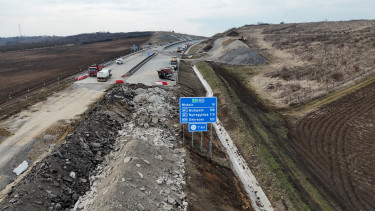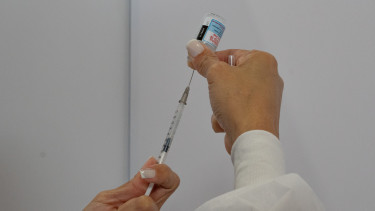COVID-19: Fewer patients in hospital, but in worse condition than a year ago in Hungary

The number of new confirmed daily COVID-19 cases is lower than a year ago but the key metric in the current 'wave' is the number of patients in hospital and on ventilator, which figures are far less reassuring.

Number of patients in hospital, days spent in hospital
The left-hand chart depicts the accumulated number of confirmed daily COVID-19 cases and days spent in hospital by coronavirus patients. The accumulated number of new cases in the period under review is about half what we had a year ago. Up until 22 September, those admitted in hospital stayed there longer than in the base period, but then the trend changed.
The number of accumulated cases (between 28 August and 10 October) is about half (cc. 17,500) of what we had last year (cc. 33,300), yet the number of days spent in hospital is not much lower (-18%).
The conclusion is that only those infected people are detected and included in the statistics that seek help due to their severe symptoms.
On the right-hand chart you find that the both curves (accumulated number of new cases) keep more or less parallel with the columns, but the accumulated number of COVID-19 patients on ventilator is much higher in 2021.

Ratio of COVID-19 patients on ventilator to those in hospital
As regards the two charts below, the percentage of ventilated COVID-19 patients relative to the number of patients hospitalised (7-day averages) has been rising in the period under review in 2021, it was dropping in the base period. The gap, however, which could only be described as dramatic, has closed somewhat as the ratio stagnated this year and started to rise a year ago.
Previously, the gap was widening most likely because last year even those with mild coronavirus symptoms were admitted to hospital, while these days only those are hospitalised that are in severe/critical condition, hence the higher number (and ratio) of them ending up on ventilator.

Patients in hospital, on ventilator, days spent in hospital and on ventilator
The left-hand chart depicts the number of coronavirus patients in hospital and on ventilator (3-day averages) between 18 July and 10 October, both in 2020 and 2021. The right-hand chart shows the accumulated number of days spent in hospital and on ventilator by COVID-19 patients, also between 18 July and 10 October in 2020 and 2021.
On the left-hand chart we can see that the number of COVID-19 patients in hospital was largely the same in 2020 and this year up until mid-September. Thanks to vaccination coverage the number this year should not have been even half of what we had last year, especially if cross-immunity gained earlier (in the previous waves or epidemics) work.
The numbers (green columns and green area with yellow curve) basically overlapped until mid-September, and even five days ago the were extremely close (644 vs. 595). By Sunday, however, there was some 'improvement' in this sense as the 1,140 COVID-19 patients in hospital on 10 October 2020 compared with about 700 this year. That was the 'good news'.
The bad news is that the 3-day average of the number of coronavirus patients on ventilator is almost the same (110 a year ago vs. 107 currently).
On the right-hand chart, the ratio of days spent in hospital to the accumulated number of COVID-19 cases is close to 95% this year (pinkish columns), while it was less than 63% last year (green area). The conclusion is the same. At least 60% more coronavirus patients should be in hospital to match this ratio, and there are still a lot more than what the number of cases would warrant. If the detection rate of coronavirus infections was considered low in 2020, it’s cannot even be registered this year.
The number of days spent on ventilator relative to the accumulated number of new cases was around 4.4% last year (green curve), while it is 13% this year (red curve). What’s the deal here?
What we see is the piling up of various factors: (i) underdetection, (ii) fewer people in hospital than there should be, (iii) patients hospitalised in more serious condition.

Accumulated number of COVID-19 cases and fatalities, days spent in hospital and on ventilator
On the left-hand chart, the green curve shows the accumulation of new cases in 2020 (in the period under review) which correlates more with the black columns, i.e. the accumulated number of COVID-19 deaths in 2021. Why is that? The number of detected cases is half this year than in the base period; see the green and the yellow curves. (Additionally, the test positivity rate is also half, but that’s another story).
This wave / eidemic was deadlier than it was in the same period a year ago until mid-September, but, as the columns attest, the situation has improved in this respect since then. Not that this many Covid fatalities were acceptable, only the second wave was more devastating in this particular comparison.
On the right-hand chart you see that the accumulated number of days coronavirus patients spent in hospital this year was higher than in 2020 in the period under review up until 22 September (red columns are higher than the light blue columns), while the number of days spent in ICUs is about 63% higher than the 2020 data.

The following charts also show how the Covid fatality situation changed from month to month since August.

This is either a 'wave' of unvaccinated people or a 'wave' that is affecting everyone, only those that have been vaccinated have a much higher chance of avoiding severe symptoms, hospitalisation and death.
We wrote about the possible scenarios in more detail below:
Clearly, we cannot fully compare the current situation to the one we were in a year ago for a number of reasons. Yet, based on the current trends, looking back might just give us an idea of a possible future. And that does not look good. The charts on the right go up to 31 October 2020, and considering that the number of coronavirus patients in hospital is almost as high, and more of them are on ventilator, well... you draw the conclusion. It's fairly safe to say that things are more likely to get worse before they would start to improve.


Vaccination concerns
Given that vaccinations have practically stalled at a vaccination coverage of about 60%, and the cabinet has no intention to tighten anti-pandemic measures, we see no reason why the epidemiological situation should improve in the immediate future. There is a much greater chance that the numbers will keep worsening for a while.


According to the results of antibody level tests performed by Videoton, the situation is not reassuring in respect of China's Sinopharm vaccine, either.
The latest round of voluntary testing in progress among the company's 8,600 employees since July (with more than 800 of them tested) showed that a lot of people in the 60+ age group that have received Sinopharm jabs had an extremely low level of or absolutely no anti-SARS-CoV-2 antibodies. About 27% of this age group have received Sinopharm AND some 550,000 of them have not been inoculated against coronavirus at all.

Most reassuringly, a third dose (of Pfizer/BioNTech's Comirnaty) gave a solid boost to their antibody levels.
The average antibody count in this group of 60+ people was 141 AU/mL, and a lot of the subjects did not have even the critical 50 AU/mL. Following the third dose, which was the Pfizer/BioNTech vaccine (Comirnaty) in every case, the average antibody level shot up to 18,000.
Cover photo: MTI/Péter Komka











